![]()
![]()
![]()
Use LEFT and RIGHT arrow keys to navigate between flashcards;
Use UP and DOWN arrow keys to flip the card;
H to show hint;
A reads text to speech;
54 Cards in this Set
- Front
- Back

|
CamilleClaudel, Chatting Women,1897. Bronze and onyx, Post Impressionism -banal story line, rendering is unfinished, details in face,sculpture is supposed to be informative, intense color, messing with thetradition of bronze and coloring it with this awful green color, incrediblysmall |
|
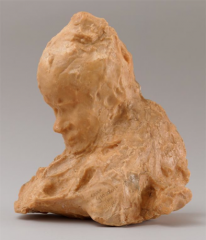
|
Medardo Rosso,The Concierge. 1883. Wax overplaster. Post Impressionism small sculpture, figural sculpture, plaster organic, moltenwax on plaster, grotesque look to it, wax not applied very carefully, surreallook to it. wax method |
|

|
Paul Serusier,Landscape (The Talisman),1888. Oil on wooden cigarbox. Post impressionism Serusier-founder of the les nabis Les Nabis-The Nabis (from the Hebrew and Arabic term for "prophets,") were a Symbolist, cult-like group founded by Paul Sérusier, who organized his friends into a secret society. Wanting to be in touch with a higher power, this group felt that the artist could serve as a "high priest" and "seer" with the power to reveal the invisible. The Nabis felt that as artists they were creators of a subjective art that was deeply rooted in the soul of the artist. While the works of the Nabis differed in subject matter from one another, they all ascribed to certain formal tenets - for example, the idea that a painting was a harmonious grouping of lines and colors. |
|
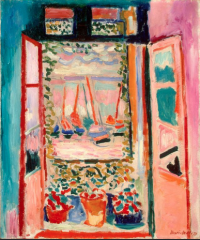
|
Matisse, Open Window,1905. Oil on canvas. Fauvism, - Matisse was the leader of Fauvism, fauves-wild beats so they were calling themselves animals, exhibition at salon, autumn salon was in contrast to leading artistic salon in europe described the young painters as wild beasts-where the name comes from -- saturated and rich color pushed to the extreme -weird angle making the windows appear to be doors, pottedplants, sail boats, bolder chunkier registers of paint, color suggest theatmosphere, messy work, completely artificial, lack out outline thereforeeverything becomes very flat with lack of understanding of depth, window doorsare very different sizes and are at different perspectives, can see the canvascoming through |
|
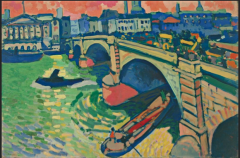
|
André Derain, London Bridge, 1906. Oil oncanvas. Fauvism -similar to fauvism with a lack of finite detail, artificial color vs exaggerated color,carefully applied |
|
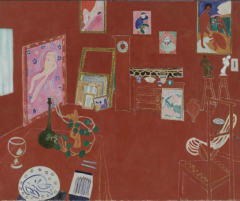
|
Matisse, The Red Studio, 1911. Oil on canvas. 6’x7’. Fauvism -his studio, self referential work, details stripped out inplaces, patches of color on the wall that appear to be paintings, the flatpaintings articulate the room, giving significance to his own work, he wantsyou to see the sculptures and paintings on the wall, contours are white andnegative space |
|
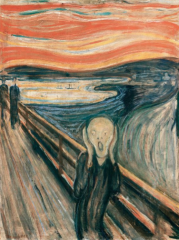
|
Munch, TheScream, 1893. Oil andtempera on board. expressionism Proto-expressionism -inner struggle, anxiety, strange rendering of human formthat seems inhuman, hole in the abyss, the internal scream |
|

|
James Ensor, Portrait ofthe Artist Surrounded by Masks,1899. Oil on canvas. Expressionism Proto-expressionism -very modern in handling of paint, ties to particular citiesin Belgium and their traditions, a critique of Belgian society, end of lentwith Carnival (Karmis in Belgium), people who were pious Catholics were actingfoolish during Carnival, the ones with masks see it as an excuse to act sinful,people who you know become strangers to you, lived above a general store andsold costumes, somewhat of a hypocrite and a misanthrope, offended people withthat painting. |
|
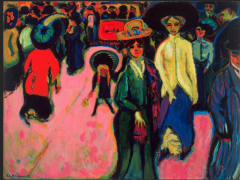
|
Ernst Ludwig Kirchner, Street, Dresden, 1908. Oil on canvas. 4 ft.11 1/4 in. x 6 ft. 6 7/8 in. Expressionism, Die Brucke Kirchner, street, Dresden-makes bourgousie look evil., harshinfluence of Parisian -His jagged, angular brushstrokes, acidic colors, and elongated forms all charge the street atmosphere on the canvas and achieve something very rebellious for its time and exemplify the stylistic break with tradition that the members of Die Brücke sought. As a founding member of the group, Kirchner set out to establish a new order of painting, one that visibly renounced Impressionistic tendencies and the need to accurately portray figurative forms. |
|
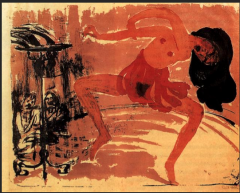
|
Emil Nolde, Female Dancer, 1913. Color lithograph. expressionism, Die Brucke -lithography, lithograph goes against this dramaticheritage, lithography is a printing process, a flat stone that is wet, you drawonto it with a wax crayon, and when you ink it the ink seeps into the stone andthe wax protects it. Preoccupation of sexualized women, skirt is veryrevealing, sense of animalistic, tribal dance which is the opposite of ballet,critiquing France and Russia, screaming with intensity, polychrome with atleast two colors and black, in this year 1913 there was an infamous musicalwork releaser—Right of Spring, aggressively rhythmic, exposure and freedom ofthe body |
|
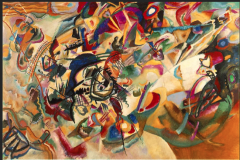
|
Vassily Kandinsky, Composition VII, 1913. Oil on canvas. 6 ft. 6 3⁄4 in. x 9ft. 11 1/8 in. Expressioism/ pure abstraction. Der Blaue Reiter -color is spiritual and synesthetic, psychological effects…to say color is interesting because it is unnatural is superficial -Kandinsky's push for abstraction was predicated upon a belief that mankind lived in the end of times and required spiritual rebirth. Kandinsky's prewar masterpiece |
|
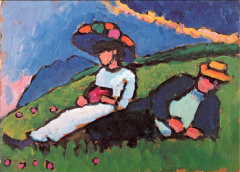
|
Gabriele Münter, Jawlensky and Werefkin, 1908-09. Oil oncardboard. 13 x 17 1⁄2 in. Expressionism, Der Blaue Reiter -something out in the hills somewhat naturalist, Urbandwellers that are commuting with nature as a safe haven, one of the few womenexpressionists in this group, Women were clearly more accepted at home at DerBlaue Rieter, recalls accentuated color of Derrain, Munter has directconnection to the fauvist group, impasto, human forms broadly generalized, theyhave nothing to say besides wanting to be together, trouble in paradise, perhapsfriends in a dispute |
|
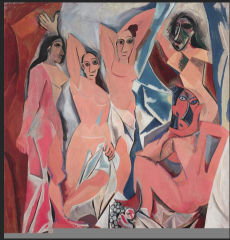
|
Picasso,Les Desmoiselles d'Avignon(The Young Ladies of Avignon),1907. Oil on canvas.cubism -first real work he did of complete cubism onlarge scale, sense of special depth—can tell that they are in a room and thereis a still life in front of them and it looks like they are standing in frontof curtains, staged scene in a studio, interest in simplification of thewomen’s body, all but one of them are nude. Genitals are inverted triangles,and the breasts are a mix over semicircles and triangles, eyes have an Egyptianaesthetic, use of profile view, two women on the right have an influence ofAfrican mask sculpture, Picasso is appropriating the visual approach for peoplehe doesn’t have much regard for, idea of primitivism Picasso is supporting,creates an idea that Africa and places like that are primitive art andundefined art, good intention but they miss the mark, steal African aestheticand fetishize it in their own works, phonetic display of disjointed forms, formsaren’t so simplified but made more complicated as it is made with morefractured form, sexually erotic, suggestive poses, desmoiselles—slang forprostitute, immoral behavior, Avignon is a city in France that was veryhistorically important, the papacy breaks apart, two different conflictingVatican’s—one in Vatican city and one in Avignon, title suggests deep catholicreligious connection, almost as if he was stating nuns were prostitute and thiswas seen as an outrage morally. |
|
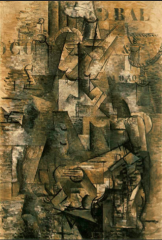
|
Braque, The Portuguese (TheEmigrant), 1911. Oil on canvas.cubism -similar treatment of the body, false volume objects, somewhatarticulation of facial features, distorted suggestions of the body get somewhatlost, useful instrument suggested, articulation of text, in analytic cubismthey often depict typography, could be a storefront, advertisement, label oftheir jacket or label of guitar, or newspaper, or anything, they remove it fromthe origin and place the letters in the work |
|

|
Picasso,Maquette for Guitar, 1912.Cardboard, string, wire.Cubism -gets sick of analytic cubism, there’s only so much you cando so he moves on, works that are a series of planes interessecting and lyingon top of eachother, familiar motif, still life quality, taken cardboard andcut it into guitar like shapes, automatically read this as guitar but nothingis proportionate, inverted guitar, frets and strings loose, literal volume tothe work, emphasizing internal space of the sculpture referencing Russianconstructivism |
|

|
Picasso, Guitar, SheetMusic, and Wine Glass, 1912.Charcoal, gouache, and pastedpaper. cubism -collage-flat and pasted together, occurring interest inchanging of forms and breaking it up, synthetic-very broad plains of colorbroken up, synthetic mode-rendering image complete from different parts. Sensethe form of the guitar without it being complete, background is wallpaper, theform of the guitar is not continuous. Glass is negative space blocking wherethe hump of guitar would be. Most you get is a fragment of an idea or word.They like the word “Jou” as it can be many different things. Typography expandsin cubism, the text becomes clearer without being complete. |
|
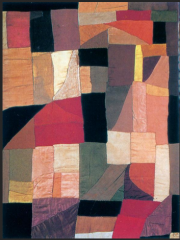
|
Sonia Delaunay-Terk,Blanket, 1911. Appliqued fabric.Ophism -cubist arrangement of color, intensified color, interestedin squares created of rectangular and triangular forms. A medium associatedwith craft that she is trying to translate into modernism. Seen as dated andgendered and trying to make it new |
|

|
Balla. Dynamism of a Dog on a leash (Leash in Motion). 1912. Oil on canvas. Futurism - interested in more quaint subjects, see velocity in everyday subjects, calm walk shown with intense speed, preserving after images,wants the after image to look like an after image, web of mesh, multiple legsmoving, fans of transparent noise, tail multiplied from movement, dog seems tobe going a lot faster because a dogs legs are smaller and have to move quickerin order to keep up, ` -Futurism kept the punch of color, they lookedtoward new technology and industry and machines, Italy is in economicdepression, They look to the future for salvation, they look to industry andtechnology as a way to get there. The Idea of Futurism is utopian because theyare trying to quicken and move toward the future and a brighter life. Identifyas fascism with their agenda, quite misogynistic, they view the problems withItaly as feminine problems. They use aggressive imagery to make men feel moremanly and aggressive. - you don't need religion, it misguides you and holds you back, technology as the new religion, nature is being negatively impacted by humans as of now |
|
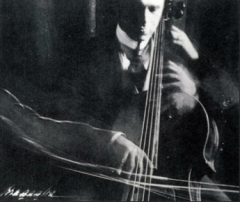
|
Anton Bragaglia, The Cellist, 1913. Gelatin. silver print. Futurism -photograph, contrast of still head and body, hair of thebow cutting back and forth that is split and multiplied, this is createdthrough a longer exposure, leaving the shutter open still captures all thelight that comes in which super imposes and over exposes the negative, figuringout how to capture time within photography. |
|
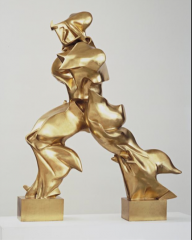
|
Boccioni,Unique Forms of Continuityin Space, 1913 (cast 1931).Bronze. Analytic Cubism, Supremtistm - analytic cubist painting, chest, something thatlooks like a head, something of a waist, thighs, and lower leg, forms seem tobe dragged behind it, almost like its fluid and its melting behind it, wavelike forms that suggest a movement forward, posture that is very quicklystepping forward, almost violent movement, given this machine like quality, amix between human and machine, Futurists were very into becoming like machine,militaristic, war like image, idea ofmodern warfare, allows it to have this glow, exaggerated by the effect thatthere are many deep cuts, strong contrast of blinding reflection an deepshadows of carvings, because it is so shiny, the light and shadow changes infront of you as you move around it and appears to become fluid. Emerging themotions into a continuous image |
|
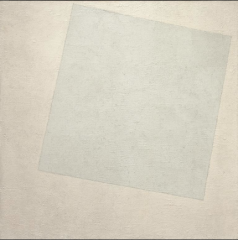
|
Kazimir Malevich,Suprematist Composition: White onWhite, 1918. Oil on canvas -supreme forms -a warm white on the outside and a cool whit on tBergson became aware that the moment one attempted to measure a moment, it would be gone: one measures an immobile, complete line, whereas time is mobile and incomplete. For the individual, time may speed up or slow down, whereas, for science, it would remain the same. Hence Bergson decided to explore the inner life of man, which is a kind of duration, neither a unity nor a quantitative multiplicity.[1] Duration is ineffable and can only be shown indirectly through images that can never reveal a complete picture. It can only be grasped through a simple intuition of the imagination.[he inside,difference of white to white is very miniscule but when its all you are givenyou cannot help but notice and it seems so obvious, The cool square beingpushed up and tilted also makes it stand out as it’s not smack in the middle,using pure geometric forms just shows that pure geometric forms do not exist innature, wants to tap into super form of the human intellect. He ants to make atype of art that is accessible to everybody. Making an art form that fitsoligarchies ideas. |
|
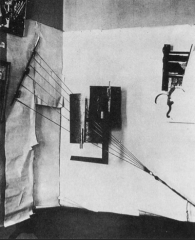
|
Vladmir Tatlin,Counter-Relief, 1915. Iron, copper, wood, rope. -constructivism- oligarchy politics, about building things, artistic labor as manual labor, idea that we are all built together. Constructivism -assemblage, assembled collage that sits on the wall, andoff the wall in the space, situated between two walls, abstract sculpture, simplya construction as an autonomous object, questioning the environment, elementsthat come from the realm of contruction, |
|
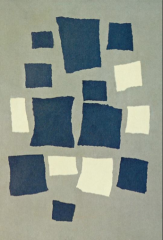
|
Hans Arp, CollageArranged According to the Laws ofChance, 1916-1917. Torn and pastedpaper. Dada -comes up with the ideas of chance, took two pieces ofpaper, ripped it up, threw the paper in the air and allowed chance to definethe composition when it fell on the floor, idea of chance belittles theartistic genius and attacks the artist by saying anything can create art—evenchance. Laws of probability seem to be removed because nothing isoverlapping—he is either really lucky or lying about the fact he used chance,this means you cant trust him or verify anything about the work at all. Even ifit is totally random there are still some choices being made such as the shapeand color and medium. one of the reasons dada goes toward the way it is, in theenlightenment, if you study nature and being rational and not irrational itwill have a positive effect. Artists become interested in rationalism pairedwith irrational violence in the war. Exposes the fallacy that rationalismpresents something meaningful but can become more rational |
|
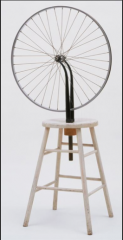
|
Marcel Duchamp, Bicycle Wheel,1913. Metal wheel mounted on painted woodstool. Dada -referencing cubism with assemblage, the objects are foundobjects but not ready made as he manipulated it, removes the functionality fromthese two objects, it took the functionality out of both and made a synthesisof the two, the meaning is up to you, two familiar objects and rendering themunfamiliar, conceptual process when you look at this and think of it. |
|
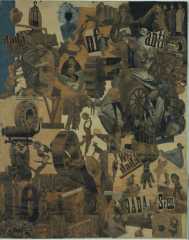
|
Hannah Höch,Cut with the Dada Kitchen KnifeThrough the Last Weimar Beer-Belly Cultural Epoch in Germany,1919. Collage Weimar period in Germany, Weimar republic is set up to gaincontrol of the public, photo collage, pasting different photographs together ona new surface, mimics the language of cubism. A lot of these images are intactand not broken up very much, infusing images of machines and humans, repetitionof the word dada, sound of baby cooing, etc. The great world dad, die antidada- self criticism of the practice of dada, something of a critique here,interested in this period of post war Germany. Drunken aspect, gendered in away from her perspective, supposedly masculine suggestion to beer, The kitchenknife being her a woman cutting image of this man run world. Referring to thestatus of women in the Weimar period1919- end of the war, women’s lit, the right to vote wasgiven to women in Germany is 1918 |
|
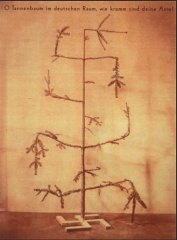
|
John Heartfield,Little German Christmas Tree,1934. Photomontage. Cubism aware of problems Hitler is causing with his fear mongering,tree is the tradition of family and holiday, but it has swastika throughout it.“Oh Christmas tree, how bent are your branches”? Rendering the branches ofGerman culture crooked, turning what supposedly makes Germany good andrendering them broken and bent |
|
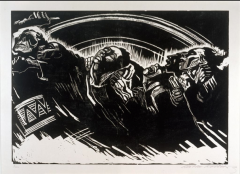
|
Käthe Kollwitz, Die Freiwilligen (The Volunteers), Plate II of theseries Krieg (War), 1922-1923. Woodcut. New Objectivity -volunteers in the first world war were not volunteers—theywere removed from their homes and forced to fight. Young German men following afigure of death, beating the war drum, violence they are going to inflict onpeople and the violence that will be inflicted on them. Knowing they won’tlikely come back and they know where they are going, already appear half dead. Concentriccircle around the whole group—halo—divine person or they are dead. Combinationof life and death , high contrast, symbolizes transformation of being alive ordead, faces are fairly well rendered, convey naturalistic. Mother intimatelyprocessing the death of her children in the war. post dada movement, return to clear imagery,return to clear thoughts, rejection of abstraction and rejection of dada,rejecton of surrealism |
|
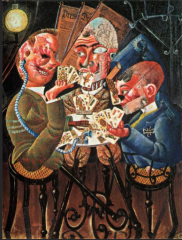
|
Otto Dix, Skat Players(Card Playing War Invalids), 1920.Oil and collage on canvas. New Objectivity, -3 figures that are all leading commanders in varioussections of the war effort in Germany. Bodies are disfigured, although appearto be having a good time but are very mutilated, unwanted cyborgaspect—replaced with industrial things in order to replace their organs but ita way that would barely benefit. post dada movement, return to clear imagery,return to clear thoughts, rejection of abstraction and rejection of dada,rejecton of surrealism |
|
|
Compostite Perspective |
- a convention of representation in which part of a figure is shown in a profile and another part of the same figure is shown frontally, also called twisted perspective |
|
|
Monochrome |
- one color/ one shade |
|
|
Lost wax method |
- a bronze casting method in which a figure is modeled in wax and covered with clay; the whole is fired, melting away the wax (French, cire perdue) and hardening the clay which then beomes a mold for molten metal |
|
|
Les Nabis ("The Prophets") |
The Nabis (from the Hebrew and Arabic term for "prophets,") were a Symbolist, cult-like group founded by Paul Sérusier, who organized his friends into a secret society. Wanting to be in touch with a higher power, this group felt that the artist could serve as a "high priest" and "seer" with the power to reveal the invisible. The Nabis felt that as artists they were creators of a subjective art that was deeply rooted in the soul of the artist. While the works of the Nabis differed in subject matter from one another, they all ascribed to certain formal tenets - for example, the idea that a painting was a harmonious grouping of lines and colors. |
|
|
allegory |
a story, poem, or picture that can be interpreted to reveal a hidden meaning, typically a moral or political one. ex: Ubermensch |
|
|
Exagerrated Color |
'Les Fauves' believed that color should be used at its highest pitch to express the artist's feelings about a subject, rather than simply to describe what it looks like. Fauvist paintings have two main characteristics: extremely simplified drawing and intensely exaggerated color. Fauvism was a major influence on German |
|
|
Artificial Color |
Forms articulated with contour lines, artificialexaggeration of color, ex: if you see something purple paint it green. Ex: the dining room on the Garden/ fauvism |
|
|
Woodblock Print (Woodcut) |
-A wooden block on the surface of which those parts not intended to print are cut away to a slight depth, leaving the design raised; also, the printed impression made with such a block |
|
|
Die Bruecke ("The Bridge) |
-"the bridge, intended to be the bridge between past and future", show displeasure of the effects of industrializationon germany German, "the bridge" An early 20th c German Expressionist art movement under the leadership of Ernst Ludwig Kirchner. The group thought of itself as the bridge between old age and new. Rise of bourgeoisie and lack of sense of self |
|
|
Nihilism |
there’s no meaning to the world, actions don’thave any reactions, you won’t be judged by a higher power because there is noneso live however you choose, Contrast in belief systems between these two brothers.Internal struggle between these deeply held beliefs and the conflict thatarises in this Claustrophobic room, very tense scene, woodblock adds energy andinstability to the work -ex: Two men at a table, Heckel heckel-. He is a Nileism, fatalist, nothing you can do |
|
|
Ubermensch (Nietzsche) |
In his 1883 book Thus Spoke Zarathustra (German: Also Sprach Zarathustra), Nietzsche has his character Zarathustra posit the Übermensch as a goal for humanity to set for itself. how a man should be more than just human-all-too-human, regardless if he was one or not. Superman, German Übermensch, in philosophy, the superior man, who justifies the existence of the human race. "Overman, Overhuman, Above-Human, Superman, Superhuman, Ultraman, Ultrahuman, Beyond-Man" It is a work of philosophical allegory, with a structural similarity to the Gathas of Zoroaster/Zarathustra. Übermensch to be the meaning of the earth and admonishes his audience to ignore those who promise other-worldly hopes in order to draw them away from the earth Zarathustra declares that the Christian escape from this world also required the invention of an eternal soul which would be separate from the body and survive the body's death. Part of other-worldliness, then, was the abnegation and mortification of the body, or asceticism. Zarathustra further links the Übermensch to the body and to interpreting the soul as simply an aspect of the body. Zarathustra first announces the Übermensch as a goal humanity can set for itself. All human life would be given meaning by how it advanced a new generation of human beings. The aspiration of a woman would be to give birth to an Übermensch, for example; her relationships with men would be judged by this standard |
|
|
Der Blaue Reiter ("The Blue Rider") |
-more interested in the spirtual aspect of art and transcending the mundane, non-objective or abstract painting out in the boonies, in Munich, no cosmopolitan vibe, lessinterested in social critique, interest in expressive form, adapting fauvisminto own purposes, Kandinsky is the central of the group—not German but I isRussian, published their own works—handmade artist books Kandinsky, Marc,Muenter, Werefkin, Klee, look to local legends, virtue of refusing to critiquethings they think is wrong with modern, Swiss approach, finding safe haven inproduction. The German "the blue rider" early 20th c german expressionist movement founded by Vassily Kandinsky and Franz Marc. The artists selected the whimsical name because of their mutal interest in the color blue and horses. |
|
|
Pure abstraction |
purely abstract works, complete no reference tothe natural world, pure color, pure form, pure line, pure planes, composition 7 is far more abstract thancomposition 2, - ex: Kandinsky composition VII he wantedpeople to look at his painting the same way they would listen to an orchestrawith durational quality, he wants you to have these aesthetic realizations thatare durational, interested in making connections with senses |
|
|
Synesthesia |
paths of senses, you see a color and associate it with asound, he claimed that when he would see certain colors if would give differentexperiences to you. Such as associating orange with trumpets through thisexperience you could have a spiritual awakening - color is spiritual, has psychological effects, to say color is interesting because it is unnatural is superficial |
|
|
analytic/ synthetic cubism |
- analytic-the first phase of cubism, developed jointly by Pablo Picasso and Georges Braque, in which the artists analyzed form from every possible vantage point to combine the various views into one pictorial whole. -synathetic-a later phase of cubism in which paintings were constructed from objects and shapes cut from paper or other materials to represent parts of a subject, in order to engage the viewer with pictorial issues, such as figuration, realism, and abstraction. ANALYTIC CUBISMAware of what they are doing on a conscious scale, rearrangespace from all point of view, depicting the many angles close togethersuggesting shape -similar treatment of the body, false volume objects, somewhatarticulation of facial features, distorted suggestions of the body get somewhatlost, useful instrument suggested, articulation of text, in analytic cubismthey often depict typography, could be a storefront, advertisement, label oftheir jacket or label of guitar, or newspaper, or anything, they remove it fromthe origin and place the letters in the work -synthetic |
|
|
typography |
Typography is the art and technique of arranging type to make written language legible, readable, and appealing when displayed. The arrangement of type involves selecting typefaces, point size, line length, line-spacing (leading), letter-spacing (tracking), and adjusting the space within letters pairs (kerning).Typography expands in cubism, the text becomes clearerwithout being complete. |
|
|
Collage |
- a composition made by combining flat surface various materials, such as newspaper, wallpaper, printed text and illustrations, photographs, and cloth. |
|
|
Assemblage |
- an artwork constructed from ready existed objects. |
|
|
Duration (Bergson) |
Duration (French: la durée) is a theory of time and consciousness posited by the French philosopher Henri Bergson. Bergson became aware that the moment one attempted to measure a moment, it would be gone: one measures an immobile, complete line, whereas time is mobile and incomplete. For the individual, time may speed up or slow down, whereas, for science, it would remain the same. Hence Bergson decided to explore the inner life of man, which is a kind of duration, neither a unity nor a quantitative multiplicity.[1] Duration is ineffable and can only be shown indirectly through images that can never reveal a complete picture. It can only be grasped through a simple intuition of the imagination.[ -how someone thinks of time-a memory |
|
|
Chance |
idea of chance belittles the artistic genius andattacks the artist by saying anything can create art—even chance. Laws of probabilityseem to be removed because nothing is overlapping—he is either really lucky orlying about the fact he used chance, this means you cant trust him or verifyanything about the work at all. Even if it is totally random there are stillsome choices being made such as the shape and color and medium. |
|
|
Readymade |
a ready made is a found object that isunchanged, a found object that you do not have to do anything to and it isready to exhibit |
|
|
Non-retinal (Duchamp) |
the found object and the ready madethe found object means using materials that are premade,found objects can be manipulated, a ready made is a found object that isunchanged, a found object that you do not have to do anything to and it isready to exhibit, the idea is all objects have a meaning, when something suchas a stool is taken out of its familiar specificity and put into new contextsuch as a gallery it has a new meaningAllows chance to fall down as a rope and take its own form,something that has produced a sculpture, placed in wooden box, like the idea ofart being a system of actions and probabilities, idea art is an idea itself, art is non retinal—non optical, not about art derived fromthe eye, but about thinking about it |
|
|
Architectonic |
-of or relating to architecture or architects |
|
|
photomontage |
-a montage constructed from photographic images. |
|
|
Merz (Schwitters) |
Merz (art style) is a synonym for the more common expression and term Dada,[1] |
|
|
Unheimlich (uncanny) |
"Uncanny" divided into three sections:Definition of the uncanny; definitions of the term itself; the semantic field of the opposition of the German words heimlich and unheimlich. |

